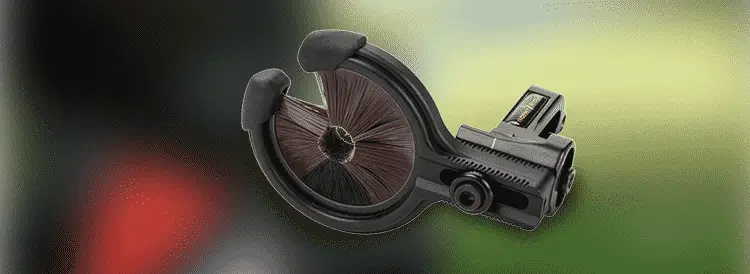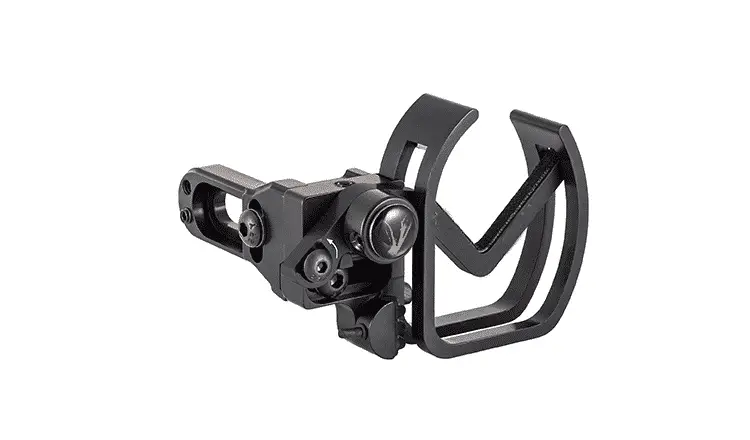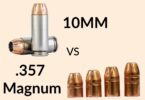Everything planned by man has qualities and shortcomings, and this guideline applies to individual rests and general classes. Choosing your perfect type may seem difficult. But fret not, as we’re here.
We’ll guide you through 5 different arrow rests and share valuable insights so you can make an informed decision. Using this guide, you may also know the underlying differences among the rest.
What Is an Arrow Rest?
Arrow rest is a shoulder of horn or metal utilized on a few bows to help the arrow. The function of the arrow rest is quite simple: hold your arrow in position and bolster the arrow until you fire the bow.
There is no ideal rest for everybody and each application. Like most things you purchase, each kind of arrow rest has advantages and disadvantages to consider.
And keeping in mind that it isn’t essential to purchase the most costly model, a quality arrow rest, related to a quality sight, will enhance your precision and achievement in the field.
If you’re hoping to enhance your giving, introducing a quality arrow rest is an extraordinary place to begin.
5 Arrow Rest Types Explained
In case you’re shooting a cutting-edge focus shot cutaway bow, you have a wide assortment of arrow rest plans to browse.
Current bows are commonly penetrated and tapped to the equivalent AMO specs, so any brand of arrow rest fits any bow for all intents and purposes.
For instance, you don’t need to pick a PSE rest to run with your PSE bow. You can pick, for all intents and purposes, any rest available. There are varieties of arrow rest, namely;
- Shoot-through/Prong-style
- Capture/ Containment
- 3D and Specialty
- Drop Away/ Fall Away
- Pressure/ Plunger
1. Shoot Through Arrow Rest
At one time, the shoot-through arrow rest was the most widely recognized. The installation is basic, because the plan is basic, simple to utilize, and dependable.
This style of rest comprises two prongs with dispersing that is movable to around two-thirds of the measurement of the arrow and functions admirably for general applications. They are pretty straightforward when set up and used.
Usability of Shoot-Through Models
Target archers are those that should consider using this arrow rest. They are one of the most commonly used compound bow arrow rest types across the country.
Advantages
- They are very affordable
- The prongs are customizable and can oblige a broad scope of narrow widths
- The level openings of the prongs are impeccable to suit vertical flexing. The rigs, in this manner, are ideal for mechanical discharge
Disadvantages
- Keeping arrows on the prong is pretty difficult
- It lacks arrow containment
Popularity Trends
Shoot-through arrow rests are one of the most straightforward types of arrow rests.
These rests fill in as a sitting point for the arrow, and the arrow slides over the highest point of the rest amid downside and discharge.
When you shoot with this rest, your base fletching or cock fletch goes specifically through the rest and ought not to interact with the rest itself if set up legitimately.
To diminish clamor on the disadvantage, I would fix the prongs of the rest with some felt. In any case, after a great deal of shooting, the felt must be supplanted as it wears out.
2. Capture/Containment Arrow Rests
This sort of rest disposes of arrows falling off the rest by enclosing the pole or “catching” it on no less than three sides and containing it until the discharge. These two terms are utilized reciprocally, and for clearness, it additionally alludes to capture rests.
Usability of Capture/Containment Models
These archery arrow rest types are mainly used by bowhunters countrywide.
Advantages
- Containment Arrow Rest works well with finger and machine releases
- It accommodates a wider range of arrow width
- It reduces errors when shooting
- The arrows are very much contained and don’t tumble off. This element causes you to enhance your point.
Disadvantages
- It interferes with arrows flight They additionally amplify blunders in shooting methods.
- A decrease in speed, for instance, will be all the more harmful to your gatherings when utilizing a catch rest than when utilizing a prong-style rest.
Popularity Trends
Everything considered the containment rest offers some critical focal points, particularly for hunting.
Regardless of whether you hunt from the beginning a tree stand, a containment rest guarantees that your arrow is prepared to shoot consistently. No talk of regulation rest is finished without particular notice of the wonder.
While bad-to-the-bone aficionados keep discussing the advantages and disadvantages of the rest, this arrow rest has come to absolutely command the containment rest showcase – and the bigger arrow rest advertise so far as that is concerned.
Ever Heard of the Whisker Biscuit Version?
While the Whisker Biscuit still gets an “adore it or detest it reaction,” it is by a wide margin the most major decision among new bow hunting lovers, and the perceived standard in containment arrow rests.
Truth be told, there have been many “thump-offs” in recent years – comparable rests that are made explicitly to rival the Whisker Biscuit.
Choosing the right archery equipment is essential for accuracy and precision.
And keeping in mind that a considerable lot of them have posted great specialized difficulties, they can only constrain shoppers from discharging their squeezes on the Whisker Biscuit.
Fletching harm or not, incalculable, a massive number of bowhunters worship this rest.

Why Is It Distinguished and Popular?
Even though not all containment rests are intended to reach the arrow’s fletching, the most prominent of the containment rests (The Whisker Biscuit) is structured along these lines.
With continued shooting, this sort of rest, in the end, wrinkles vanes, and wears out the edges of feathers.
Since the rest reaches every one of the three fletchings all the while, the net impact on arrow flight is unimportant – less derivation in speed.
Then again, containment rests with 3-point contacts (like, for example, the Bodoodle Zapper) that are planned NOT to reach. Be that as it may, they can be especially particular about nock and fletching arrangement, much like a shoot-through rest.
A portion of the 3-point containment rests structured with genuinely little leeway holes which can’t oblige most counterbalance and helical fletching.
So a straight fletch might be required if you pick a 3-point type containment rest.
3. Drop Away Arrow Rests
Drop Away Arrow rests have been around for some time, yet they have genuinely flooded in fame and plan modernity over the most recent couple of years.
Some people call them “fall-away” rests. The drop away arrow rest is intended to drop off compacted way, & wipe out worries about fletching freedom.

Usability of Drop Away Models
These archery arrow rest types prevail in competitive (Target)archery, but can also be used in hunting.
Advantages
- It has minimal contact with the arrow
- It enhances accuracy by parting the arrow’s airlift openly uninterrupted. While making the target shooting the fall away would be the best.
- Falling away makes these rest awesome for horizontal and vertical flexes.
Disadvantages
- It can fail at any time as this is automated.
- The setup can be difficult
- It is quite noisy
Popularity Trends
There’s no precluding the advantage of securing a legitimately working drop-away arrow rest.
For the individuals who shoot to a great extent settled edge broadheads, which can be troublesome to balance out, the drop away, is a preferred primary standpoint – as it allows the utilization of substantial helical fletching when all is working legitimately.
Since most drop-away rests make less rubbing between the arrow and the arrow rest, you can also rely on picking up a couple of additional FPS for your inconvenience.
4. Pressure/Shoot-Around/Plunger Arrow Rests
The term “Pressure Rest” is synonymous with “FingerShooter Rest” for all intents and purposes. They’re now and then likewise called “Shoot-Around” rests.
This is an extraordinary kind of rest that “pushes back” from the side to help check the even wavering of an arrow discharged with fingers.
Usability of Pressure/Plunger Models
Pressure plunger rests are very popular among archers and hunters.
Advantages
- It is easy to use
- It is quite durable
- A good value for money
Disadvantages
- It is becoming less popular
Popularity Trends
These rests will enable the finger shooter to alter the measure of strain (pressure) the rest applies on the arrow to get the ideal tune from a finger-discharged bow.
It will be ideal if you take note that a portion of these plans may work with an inside shot cutaway riser bow.
If you shoot a more established bow without the advantage of an inside shot cutaway riser, you may need to pick a standard Flipper or Springy rest.
Some Pressure Rests won’t have enough flat travel to suit the middle shot on an older bow.
5. 3d/Specialty Arrow Rests
All other arrow rests are groped as specialty arrow rests. This rest is for the objective bowman who enjoys bunches of flexibility and a rest that can confront the rigors of rivalry and practice.
Usability of 3d/Specialty Models
These arrow rests are often used in competitions wherein many archers compete for victory.
Advantages
- Excellent rest
- Easy to use
- Super quiet
- Great performance
Disadvantages
- It is quite pricey for beginners to afford
Popularity Trends
Given the market elements, if you ever happen to utilize this arrow rest, no other item will attempt to contend it as your top choice.
It is easy to utilize rest within general uncommon quality.
This is only the best arrow rest that includes every one of the fancy odds and ends you are hoping to support your chasing endeavors.
On the off chance that shooting is your objective, the characteristics of an arrow rest you need to go for are unquestionably not precisely those characteristics of the arrow rest for seekers.
Since you won’t swim through the shrubbery and woods, you should think about something other than toughness like this.
All you require is a lightweight item that can be balanced without much stretch, even amidst the brandishing action.
Most shooters extraordinarily lean toward the prong-style arrow rest.
This is a direct result of the exactness of shots described with these rests, notwithstanding their straightforwardness in change.
Having imagined your ultimate objective, you should now have a superior thought of what kind of rest may be best for you.
Regardless of whether you have set up, it may be amusing to take a stab at something new to perceive how it influences your precision.
Make sure to consider the kind of vanes you’re shooting, the separation, and the shape while choosing your next rest!
HAPPY SHOOTING!
FAQs:
Which Way Do You Adjust Arrow Rest?
Generally, you want the arrow rest to be angled slightly towards the bow riser, with the arrow passing over the center of the riser. You can adjust this angle by loosening or tightening the screws on the side of the rest.
Why Do I Need an Arrow Rest?
An arrow rest provides a support surface for the arrow shaft, helping to keep it in line with the bowstring and target. Without an arrow rest, your shots are likely to be less accurate as the arrow may move around unpredictably due to the force of the bowstring and vibrations that occur when shooting.
How Far Should the Arrow Extend Past the Rest?
The arrow should extend approximately one inch past the arrow rest for maximum accuracy. Anything less than this can cause discomfort to your fingers and throw off the accuracy of your shots.









Leave a Comment